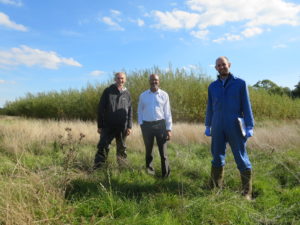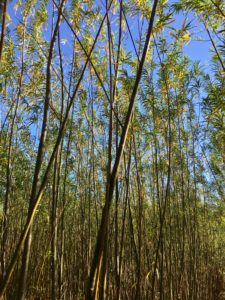I have seen the future of biomass willow and its name is RR09043

Kevin Lindegaard of C4E with Gary Crooks of Energy Crops Solutions Ltd and Will Macalpine of Rothamsted Research at the SRC willow trial at Easton and Otley College in Norfolk earlier his week.
Back in 1974 music critic Jon Landau went to a concert and then wrote an influential article in which he claimed “I saw rock and roll’s future and its name is Bruce Springsteen”. Within a year Bruce Springsteen had released Born to Run and his face was on the cover of Time and Newsweek. The rest is history.
On Tuesday this week I was shown around an SRC trial at Easton & Otley College in Norfolk by my friend and colleague Will Macalpine, the willow breeder at Rothamsted Research. The trial includes all the best willow varieties from the four willow breeding programmes from the UK and Sweden. Also included were a couple of unnamed varieties that have been bred and chosen from the progeny using the technique called Marker Assisted Selection (MAS).

RR09043 has been chosen using Marker Assisted Selection techniques. It’s very tall and has thick rods.
In terms of parentage there is not a lot of difference between new strains and old established high yielding varieties like Tora and Resolution. But in this trial they were certainly a cut above the rest – being both taller and having thicker stems. The MAS technique employed allows the molecular genetics of the plant to be compared with other similar varieties and selections made based on markers in their DNA profile. So for instance, a genotype showing a known marker for high yield would be selected. Similarly, if the genotype was missing a marker associated with low yield then that would also lead to selection.
I joked at the time that “I have seen the future of biomass willow and its name is RR09043”. We all had a good laugh about this. However, joking aside, this could be the step change that the energy crop industry requires. Serious willow breeding has been going on since 1986 and yield gains have certainly been made but mostly incrementally. When I was the willow breeder at Long Ashton Research Station between 1996-2003 we always talked about the giant leap forward – a 20% gain that could be achieved through employing molecular technology. Unless my eyes were deceiving me I think we might have got there.
This is really important as we need to make the best use of our land and gain the highest yields we can. Perennial energy crops have very good land resource efficiency and they also have a good lifecycle carbon balance – the energy used to grow the crop is about 1/20th of the energy produced. MAS varieties could increase this ratio even further.
These are early days. The genotypes are still being tested. If they pass all the other breeding criteria such as disease resistance, pest resistance, habit and ease of propagation then they will registered for Plant Breeders’ Rights and be multiplied and perhaps be available to farmers in 5 years. Furthermore, at present this technique is being used only in willow species in which we know the genomes well. There are around 350 willow species in the world so this really could be just the starting point of a green revolution for willow biomass production!
You can read more about Marker Assisted Breeding in wilow in this paper:
Genetic strategies for dissecting complex traits in biomass willows (Salix spp.)
by Steven J. Hanley and Angela Karp